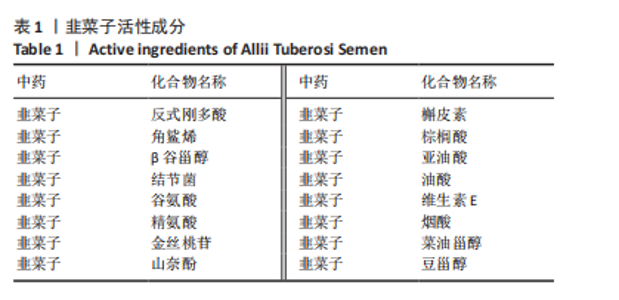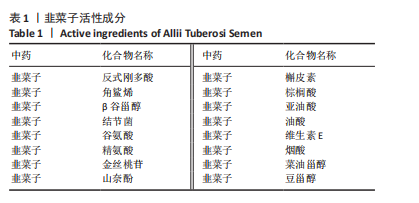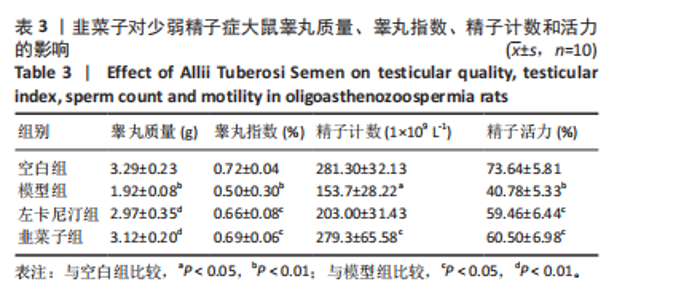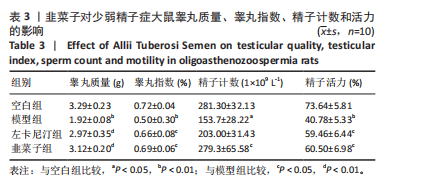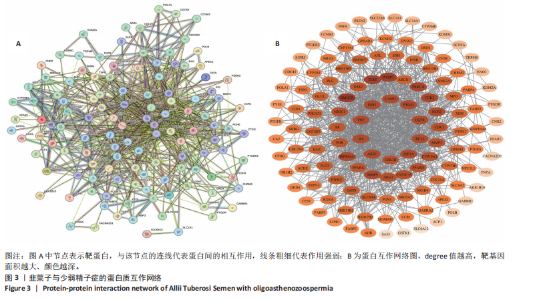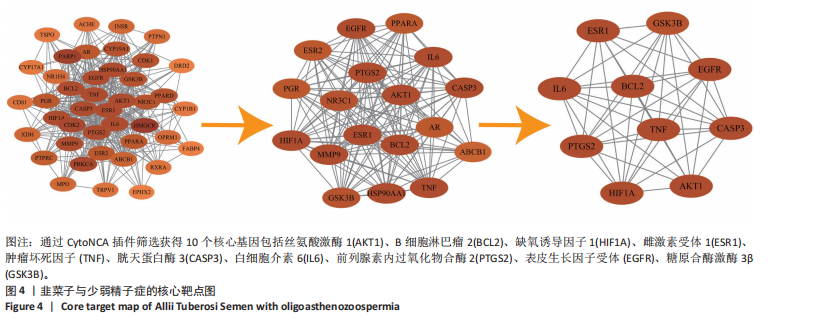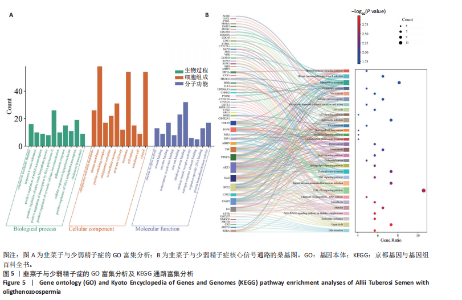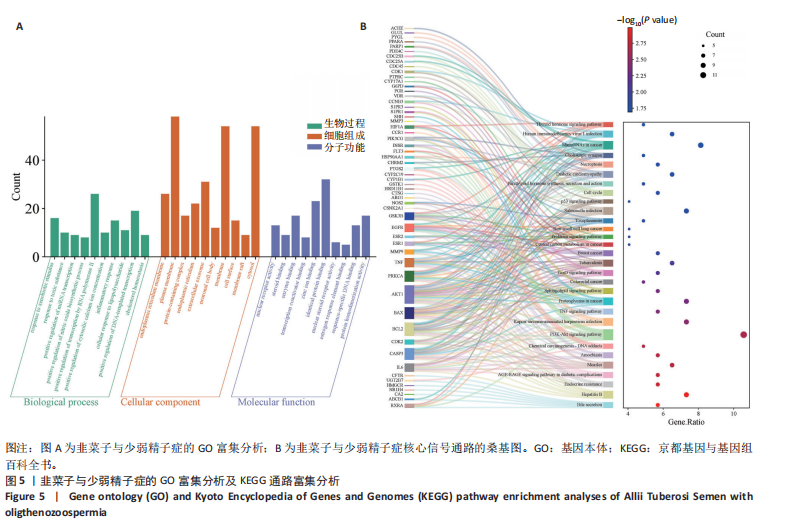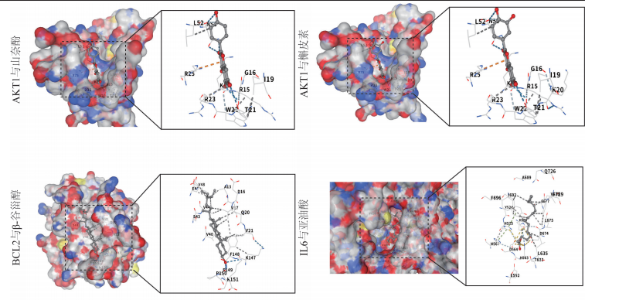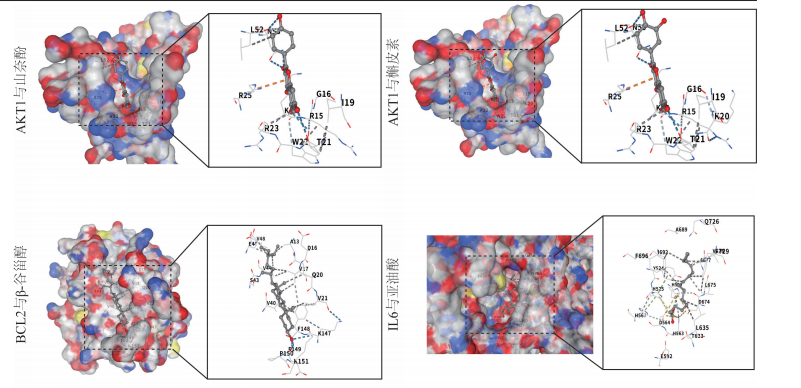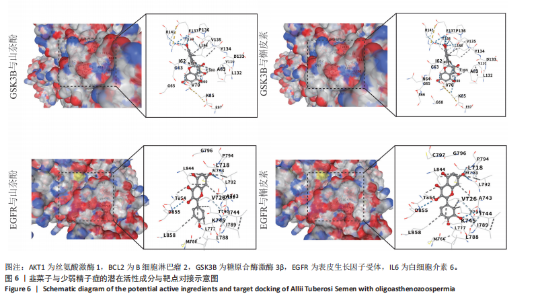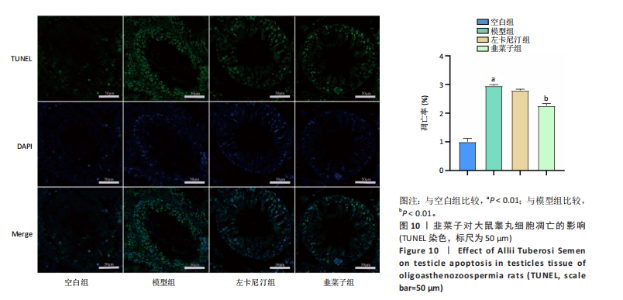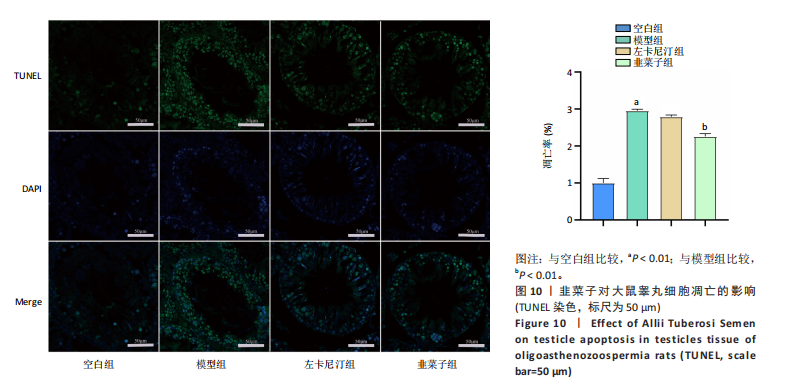Chinese Journal of Tissue Engineering Research ›› 2026, Vol. 30 ›› Issue (12): 3044-3057.doi: 10.12307/2026.665
Previous Articles Next Articles
Mechanism of multi-target intervention of the active ingredient of Allii Tuberosi Semen in rats with oligoasthenozoospermia
Jiang Huanhuan1, 2, Mu Sheng1, 2, Ma Wenxin3, Liu Chang3, Liu Ziyu3, Pu Jing3, Zhu Xiangdong1, 2, Hui Hong1, 2, Ma Huiming3
- 1College of Traditional Chinese Medicine, Ningxia Medical University, Yinchuan 750004, Ningxia Hui Autonomous Region, China; 2Key Laboratory of Modernization of Traditional Medicine for Ethic Minorities in Ningxia, Ministry of Education, Ningxia Medical University, Yinchuan 750004, Ningxia Hui Autonomous Region, China; 3Key Laboratory of Fertility Maintenance, Ministry of Education, Ningxia Medical University, Yinchuan 750004, Ningxia Hui Autonomous Region, China
-
Received:2025-06-30Accepted:2025-07-31Online:2026-04-28Published:2025-09-29 -
Contact:Ma Huiming, Professor, Master’s supervisor, Key Laboratory of Fertility Maintenance, Ministry of Education, Ningxia Medical University, Yinchuan 750004, Ningxia Hui Autonomous Region, China Co-corresponding author: Hui Hong, MS, Professor, Master’s supervisor, College of Traditional Chinese Medicine, Ningxia Medical University, Yinchuan 750004, Ningxia Hui Autonomous Region, China; Key Laboratory of Modernization of Traditional Medicine for Ethic Minorities in Ningxia, Ministry of Education, Ningxia Medical University, Yinchuan 750004, Ningxia Hui Autonomous Region, China -
About author:Jiang Huanhuan, MS candidate, College of Traditional Chinese Medicine, Ningxia Medical University, Yinchuan 750004, Ningxia Hui Autonomous Region, China; Key Laboratory of Modernization of Traditional Medicine for Ethic Minorities in Ningxia, Ministry of Education, Ningxia Medical University, Yinchuan 750004, Ningxia Hui Autonomous Region, China -
Supported by:National Natural Science Foundation of China (General Program), No. 82274624 (to MHM)
CLC Number:
Cite this article
Jiang Huanhuan, Mu Sheng, Ma Wenxin, Liu Chang, Liu Ziyu, Pu Jing, Zhu Xiangdong, Hui Hong, Ma Huiming. Mechanism of multi-target intervention of the active ingredient of Allii Tuberosi Semen in rats with oligoasthenozoospermia[J]. Chinese Journal of Tissue Engineering Research, 2026, 30(12): 3044-3057.
share this article
Add to citation manager EndNote|Reference Manager|ProCite|BibTeX|RefWorks
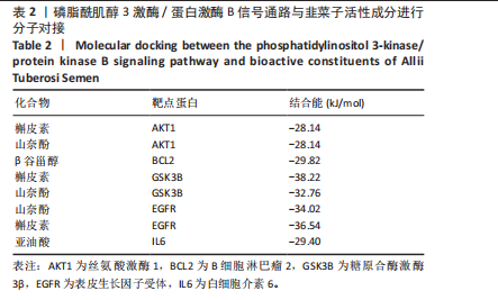
2.2 交集基因及成分-靶点-疾病关系网络构建 通过GeneCards、DrugBank、Disgenet、OMIM数据库共获取1 095个靶标。将疾病靶点与药物有效成分靶点相互交集并绘制韦恩图,最后获取韭菜子治疗少弱精子症的靶点基因共123个,构建成分-靶点-疾病关系网络,见图1,2。 2.3 蛋白互作网络分析 基于String数据库构建123个靶点基因的蛋白质互作网络,筛选综合评分> 0.4的互作关系通过Cytoscape软件可视化(图3),并运用CytoNCA和CytoHubba插件分析网络拓扑结构,最终按Degree值排序确定前10个核心靶点蛋白,具体包括丝氨酸激酶1(AKT1)、B细胞淋巴瘤2(BCL2)、缺氧诱导因子1(HIF1A)、雌激素受体1(ESR1)、肿瘤坏死因子(TNF)、胱天蛋白酶3 (CASP3)、白细胞介素6(IL6)、前列腺素内过氧化物合酶2(PTGS2)、表皮生长因子受体(EGFR)、糖原合酶激酶3β(GSK3B),见图4。 2.4 GO富集分析及KEGG通路富集分析 GO富集分析得到总条目290个,其中生物过程290个条目,主要涉及对异源性刺激的反应、对有毒物质的反应、miRNA转录的正调控、对一氧化氮生物合成过程的积极调节、核糖核酸聚合酶Ⅱ对转录的正调控、细胞质钙离子浓度的正调控、炎性应答、脂多糖的细胞反应、脱氧核糖核酸模板转录的正调控、胆固醇内稳态;细胞组成49个条目,主要包括内质网膜、细胞膜、含蛋白质复合物、内质网、胞外小泡、神经元细胞体、膜、细胞表面、膜桥、胞质等;分子功能101个条目,主要包括核受体活性、类固醇结合、酶结合、转录共激活因子结合、锌离子结合、相同的蛋白质结合、核类固醇激素受体活性、雌激素反应元件结合、序列特异性DNA结合、蛋白质同源二聚化活性等,每组选取前10个条目生成可视化三合一柱状图。KEGG通路富集分析获得51条通路,主要涉及胆汁分泌、乙型肝炎、内分泌抵抗、高级糖基化终末产物-受体信号通路、在糖尿病并发症中的作用、麻疹、阿米巴病、磷脂酰肌醇3激酶/蛋白激酶B信号通路、肿瘤坏死因子信号通路、蛋白多糖在癌症中的作用、转录因子的叉头盒O信号通路、p53信号通路、细胞凋亡、甲状腺激素信号通路,见图5。 2.5 分子对接 通过以上结果表明磷脂酰肌醇3激酶/蛋白激酶B是韭菜子改善雷公藤多苷片诱导少弱精子症的关键通路,对通路中关键蛋白进行分子对接,从PDB数据库获取丝氨酸激酶1(7myx)、B淋巴细胞瘤2蛋白(5uup)、白细胞介素6(5sfk)、表皮生长因子受体(9gdv)、糖原合酶激酶3β(8vmf)的蛋白结构文件。通过分子对接分析显示所有配体-靶点复合物的结合能均低于-25.2 kJ/mol,提示具有强效结合活性,见表2,图6。 2.6 动物实验验证结果 2.6.1 韭菜子对少弱精子症大鼠体质量、睾丸质量、精子计数和活力的影响 与空白组相比,模型组大鼠"
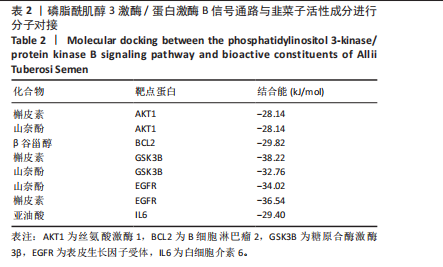
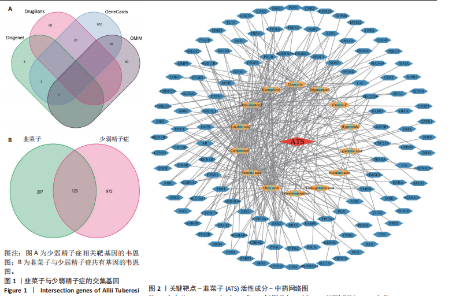
2.6.2 韭菜子对少弱精子症大鼠精子质量的影响 大鼠正常精子头部弯曲、呈镰刀型、表面光滑、顶体和顶体后区分界欠清晰、头颈部连接于腹侧、颈部细长、中段粗细一致、主段较长、逐渐变细及无成角弯折,左卡尼汀组与韭菜子组精子形态与正常精子无异,模型组精子畸形,主要有断头、卷曲、尾部折叠,结果表明韭菜子组对少弱精子症大鼠精子损伤具有改善作用,见图7。 2.6.3 韭菜子对少弱精子症大鼠睾丸组织结构的影响 苏木精-伊红染色显示:空白组大鼠睾丸生精小管结构完整,生精细胞排列有序;模型组则呈现生精小管萎缩、生精细胞排列紊乱及数量显著减少的病理改变;而韭菜子组和左卡尼汀组大鼠睾丸组织学结构明显改善,生精细胞排列基本恢复正常,见图8。 2.6.4 韭菜子对少弱精子症大鼠血清指标的影响 与空白组比较,其余各组血清睾酮水平均降低,卵泡"
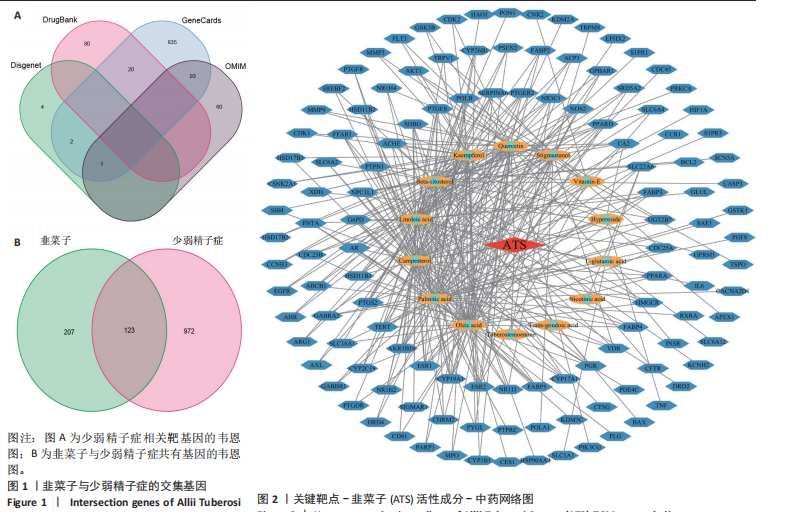
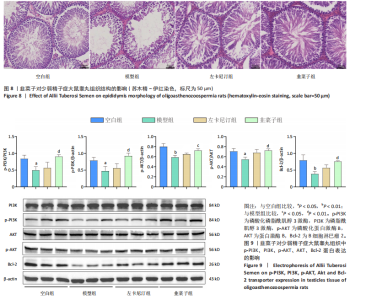
2.6.5 韭菜子对少弱精子症大鼠睾丸组织中相关蛋白表达水平的影响 与空白组相比,模型组大鼠睾丸组织中磷酸化磷脂酰肌醇3激酶、磷酸化蛋白激酶B及B细胞淋巴瘤2蛋白表达水平均显著下调(P < 0.01,P < 0.05);经药物干预后,韭菜子组、左卡尼汀组上述蛋白表达上调,其中韭菜子组对磷脂酰肌醇3激酶/蛋白激酶B信号通路的激活作用尤为显著(P < 0.01,P < 0.05),见图9。 2.6.6 韭菜子对少弱精子症大鼠睾丸细胞凋亡的影响 TUNEL检测结果显示:模型组大鼠睾丸组织细胞凋亡率较空白组显著升高(P < 0.01);经药物干预后,韭菜子组能显著抑制睾丸细胞凋亡(P < 0.01),见图10。"
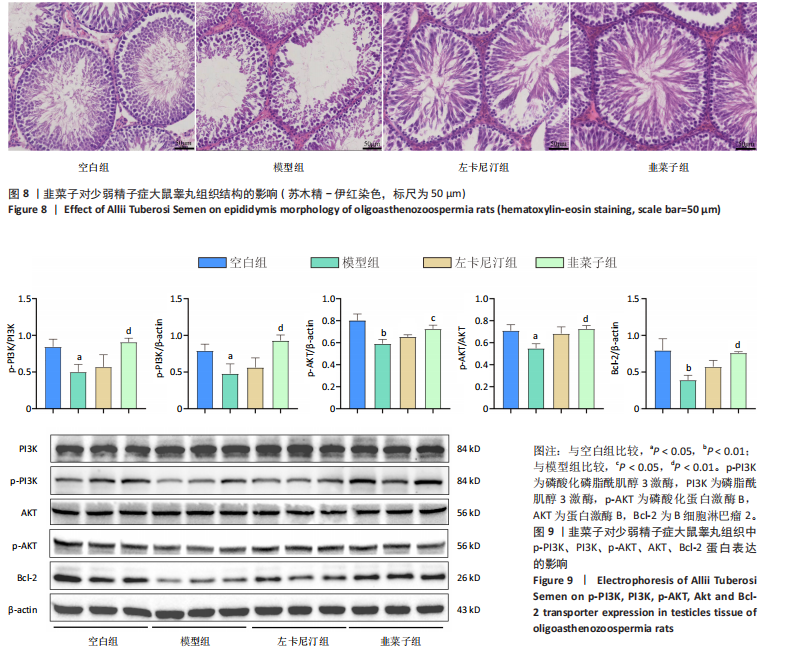
| [1] 世界卫生组织.世界卫生组织人类精液检查与处理实验室手册[J].北京:人民卫生出版社,2011. [2] GAO Y, GUO Y, WU M, et al. Molecular Mechanisms of Huangjing Zanyu Capsule in Treating Oligoasthenospermia: A Study Based on AMPK-Mediated Mitophagy. Sichuan Da Xue Xue Bao Yi Xue Ban. 2025;56(1):74-82. [3] ALAHMAR AT, CALOGERO AE, SENGUPTA P, et al. Coenzyme Q10 Improves Sperm Parameters, Oxidative Stress Markers and Sperm DNA Fragmentation in Infertile Patients with Idiopathic Oligoasthenozoospermia. World J Mens Health. 2021;39(2):346-351. [4] AMORY JK, OSTROWSKI KA, GANNON JR, et al. Isotretinoin administration improves sperm production in men with infertility from oligoasthenozoospermia: a pilot study. Andrology. 2017;5(6): 1115-1123. [5] LIU X, WANG W, ZHU P, et al. In-depth quantitative proteome analysis of seminal plasma from men with oligoasthenozoospermia and normozoospermia. Reprod Biomed Online. 2018;37(4):467-479. [6] KALLINIKAS G, TSOPORIS JN, HARONIS G, et al. The role of oral antioxidants in the improvement of sperm parameters in infertile men. World J Urol. 2024;42(1):71. [7] ZHANG S, LUO Q, MENG R, et al. Long-term health risk of offspring born from assisted reproductive technologies. J Assist Reprod Genet. 2024;41(3):527-550. [8] MA M, JU B, LI X, et al. Clinical study on the treatment of male infertility with Wuwei Fuzheng Yijing decoction based on microplastics: Study protocol for a randomized controlled trial. Medicine (Baltimore). 2022;101(41):e31265. [9] 刘红娟,吴德玲,童小慧,等.五子衍宗丸干预线粒体通透性转换孔抑制精子凋亡的机制[J].中国实验方剂学杂志,2020,26(21):34-39. [10] 赵振宁,李开颖,杨楠,等.电针调控少弱精子症模型大鼠“下丘脑-垂体-睾丸轴”的作用机制[J].中国组织工程研究,2025, 29(26):5563-5571. [11] 邹家丽,李安遥,王启铭,等.归肾经补阳药的网络药理学机制研究[J].中草药,2019,50(8):1838-1847. [12] 赵日虹,刘习平,周昭丽,等.韭菜子化学成分、药理作用及质量标志物(Q-Marker)的预测分析[J].中药药理与临床,2023,39(11): 121-128. [13] 温许诺,周玫汝,张凤婕,等.韭菜子等补肾中药能促进雷帕霉素诱导的急性退化胸腺再生[J/OL].浙江大学学报(医学版),1-16 [2025-06-19].http://kns.cnki.net/kcms/detail/33.1248.R.20250530. 1128.002.html. [14] 王华.基于Cyt-C线粒体凋亡通路探讨改良“益精方”对“肾阳虚”型少弱精症的研究及应用[D]. 兰州:甘肃农业大学,2023. [15] 孙天松,李波男,何清湖.少弱精子症动物模型建立方法及模型评价[J].中国实验方剂学杂志,2022,28(14):179-185. [16] JIAO W, SUN J, ZHANG X, et al. Improvement of Qilin pills on male reproductive function in tripterygium glycoside-induced oligoasthenospermia in rats. Andrologia. 2021;53(4):e13923. [17] 国家药典委员会.中华人民共和国药典 2015年版 一部[M].北京:中国医药科技出版社,2015. [18] 何康婧,高增平,尹丽梅,等.雷公藤多苷的药理毒理作用研究进展[J].中国实验方剂学杂志,2020,26(1):196-204. [19] 徐颖,樊媛芳,赵元,等.近40年雷公藤生殖毒性研究概述[J].中国中药杂志,2019,44(16):3406-3414. [20] 段雯,张小静,丁文捷,等.“菟丝子-枸杞子”药对调控SIRT1/Nrf2信号通路抑制氧化应激后血睾屏障损伤改善少弱精子症大鼠生精功能[J/OL].中国实验方剂学杂志,1-12[2025-06-19].https://doi.org/10.13422/j.cnki.syfjx.20250144. [21] 丛悦.韭菜子有效成分、提取方法及其在制备保护肝损伤药物方面的应用[R].郑州:河南大学,2021-07-23. [22] 周芃,郭小红,李杰,等.韭菜子不同炮制品特异性气味的GC-IMS比较[J].中华中医药学刊,2025,43(5):61-65+276-279. [23] 朱彤,吴媛媛,陈素华,等.无精子症及少弱精子症2436例患者的细胞遗传学病因分析[J].现代妇产科进展,2017,26(6):422-425. [24] 陈敏,宾彬,陆海旺.少弱精子症的中医药治疗进展[J].西部中医药,2023,36(10):158-161. [25] 李时珍.本草纲目(第二册)[M].北京:人民卫生出版社,1977. [26] 何娟,李上球,刘戈,等.韭菜子醇提物对去势小鼠性功能障碍的改善作用[J].江西中医学院学报,2007,19(2):68-70. [27] 王成永,时军,桂双英,等.韭菜子提取物的温肾助阳作用研究[J].中国中药杂志,2005,30(13):1017-1018. [28] 常家庆,赵威威,李启明,等.PI3K/Akt信号通路在少弱精子症中的作用及中医药调控研究进展[J].中国医药导报,2025,22(4):66-70+77. [29] 陈雪松,徐磊,姜子祥,等.中医药调控PI3K/AKT信号通路治疗少弱精子性不育症研究进展[J].中医学报,2025,40(5):930-935. [30] 宋佳怡,周旋,沈宏平,等.基于网络药理学和分子对接探讨还少丹治疗少弱精子症作用机制[J].新中医,2025,57(4):1-8. [31] DOWNWARD J. PI 3-kinase, Akt and cell survival. Semin Cell Dev Biol. 2004;15(2):177-182. [32] ROOPASHREE PG, SHETTY SS, SHETTY VV, et al. Inhibitory effects of medium-chain fatty acids on the proliferation of human breast cancer cells via suppression of Akt/mTOR pathway and modulating the Bcl-2 family protein. J Cell Biochem. 2024;125(6):e30571. [33] 杜琨,傅广义,苏少雄.六味地黄丸对弱精子症大鼠睾丸组织PI3K-AKT-mTOR通路的影响[J].世界中西医结合杂志,2025,20(4):725-730. [34] 徐银莹,赵洁,于昊,等.基于转录组测序分析日粮添加槲皮素对夏季湖羊睾丸组织基因表达的影响[J].畜牧与兽医,2025,57(2):1-8. [35] BU T, MI Y, ZENG W, et al. Protective effect of quercetin on cadmium-induced oxidative toxicity on germ cells in male mice. Anat Rec (Hoboken). 2011;294(3):520-526. [36] LV D, JI Y, ZHANG Q, et al. Mailuoshutong pill for varicocele-associated male infertility-Phytochemical characterisation and multitarget mechanism. Front Pharmacol. 2022;13:961011. [37] SINGH J, SRIVASTAVA S, ZEHRA A, et al. Beta(β)-sitosterol attenuates Chronic Unpredictable Stress (CUS) Induced Testicular Damage in the Experimental Rat Model. Reprod Sci. 2025;32(4):1312-1330. [38] CHRISTIN-MAITRE S, YOUNG J. Androgens and spermatogenesis. Ann Endocrinol (Paris). 2022;83(3):155-158. [39] MAKARY S, ABDO M, FEKRY E. Oxidative stress burden inhibits spermatogenesis in adult male rats: testosterone protective effect. Can J Physiol Pharmacol. 2018;96(4):372-381. [40] SMITH BK, WARD M. The Role of Testosterone Therapy in Men’s Health. Nurs Clin North Am. 2023;58(4):525-539. [41] HUANG C, QIAN C, LI Z, et al. Rosa roxburghii juice alleviates DEHP-induced reproductive system damage in male mice via the PI3K/AKT signaling pathway. J Ethnopharmacol. 2025;347:119742. [42] HIRD AW, TRON AE. Recent advances in the development of Mcl-1 inhibitors for cancer therapy. Pharmacol Ther. 2019;198:59-67. [43] DONG P, XIA L, HU L, et al. Runjing Decoction alleviated cyclophosphamide-induced oligoasthenospermia rats by inhibiting cell apoptosis via RXFP1/AKT/FOXO1 pathway. Andrologia. 2021;53(11): e14216. |
| [1] | Zhou Sirui, Xu Yukun, Zhao Kewei. Ideas and methods of anti-melanogenesis of Angelica dahurica extracellular vesicles [J]. Chinese Journal of Tissue Engineering Research, 2026, 30(7): 1747-1754. |
| [2] | Liu Anting, Lu Jiangtao, Zhang Wenjie, He Ling, Tang Zongsheng, Chen Xiaoling. Regulation of AMP-activated protein kinase by platelet lysate inhibits cadmium-induced neuronal apoptosis [J]. Chinese Journal of Tissue Engineering Research, 2026, 30(7): 1800-1807. |
| [3] | Yuan Xiaoshuang, Yang Xu, Yang Bo, Chen Xiaoxu, Tian Ting, Wang Feiqing, Li Yanju, Liu Yang, Yang Wenxiu. Effect of conditioned medium of diffuse large B-cell lymphoma cells on proliferation and apoptosis of human bone marrow mesenchymal stem cells [J]. Chinese Journal of Tissue Engineering Research, 2026, 30(7): 1632-1640. |
| [4] | He Jiale, Huang Xi, Dong Hongfei, Chen Lang, Zhong Fangyu, Li Xianhui. Acellular dermal matrix combined with adipose-derived stem cell exosomes promotes burn wound healing [J]. Chinese Journal of Tissue Engineering Research, 2026, 30(7): 1699-1710. |
| [5] | Chen Yulin, He Yingying, Hu Kai, Chen Zhifan, Nie Sha Meng Yanhui, Li Runzhen, Zhang Xiaoduo , Li Yuxi, Tang Yaoping. Effect and mechanism of exosome-like vesicles derived from Trichosanthes kirilowii Maxim. in preventing and treating atherosclerosis [J]. Chinese Journal of Tissue Engineering Research, 2026, 30(7): 1768-1781. |
| [6] | Peng Zhiwei, Chen Lei, Tong Lei. Luteolin promotes wound healing in diabetic mice: roles and mechanisms [J]. Chinese Journal of Tissue Engineering Research, 2026, 30(6): 1398-1406. |
| [7] | Jia Jinwen, Airefate·Ainiwaer, Zhang Juan. Effects of EP300 on autophagy and apoptosis related to allergic rhinitis in rats [J]. Chinese Journal of Tissue Engineering Research, 2026, 30(6): 1439-1449. |
| [8] | Guo Ying, Tian Feng, Wang Chunfang. Potential drug targets for the treatment of rheumatoid arthritis: large sample analysis from European databases [J]. Chinese Journal of Tissue Engineering Research, 2026, 30(6): 1549-1557. |
| [9] | Liu Yu, Lei Senlin, Zhou Jintao, Liu Hui, Li Xianhui. Mechanisms by which aerobic and resistance exercises improve obesity-related cognitive impairment [J]. Chinese Journal of Tissue Engineering Research, 2026, 30(5): 1171-1183. |
| [10] | Wang Zhengye, Liu Wanlin, Zhao Zhenqun. Advance in the mechanisms underlying miRNAs in steroid-induced osteonecrosis of the femoral head [J]. Chinese Journal of Tissue Engineering Research, 2026, 30(5): 1207-1214. |
| [11] | Chen Yixian, Chen Chen, Lu Liheng, Tang Jinpeng, Yu Xiaowei. Triptolide in the treatment of osteoarthritis: network pharmacology analysis and animal model validation [J]. Chinese Journal of Tissue Engineering Research, 2026, 30(4): 805-815. |
| [12] | Bao Zhuoma, Hou Ziming, Jiang Lu, Li Weiyi, Zhang Zongxing, Liu Daozhong, Yuan Lin. Effect and mechanism by which Pterocarya hupehensis skan total flavonoids regulates the proliferation, migration and apoptosis of fibroblast-like synoviocytes [J]. Chinese Journal of Tissue Engineering Research, 2026, 30(4): 816-823. |
| [13] | Yang Xiao, Bai Yuehui, Zhao Tiantian, Wang Donghao, Zhao Chen, Yuan Shuo. Cartilage degeneration in temporomandibular joint osteoarthritis: mechanisms and regenerative challenges [J]. Chinese Journal of Tissue Engineering Research, 2026, 30(4): 926-935. |
| [14] | Wang Zhengye, Liu Wanlin, Zhao Zhenqun. Mechanism by which vascular endothelial growth factor A targets regulation of angiogenesis in the treatment of steroid-induced osteonecrosis of the femoral head [J]. Chinese Journal of Tissue Engineering Research, 2026, 30(3): 671-679. |
| [15] | Chen Ling, Mao Qiuhua, Xu Pu, Zhang Wenbo. Effect of water-soluble matrix of nano-pearl powder on proliferation, migration and apoptosis of mouse fibroblasts#br# [J]. Chinese Journal of Tissue Engineering Research, 2026, 30(2): 338-344. |
| Viewed | ||||||
|
Full text |
|
|||||
|
Abstract |
|
|||||
